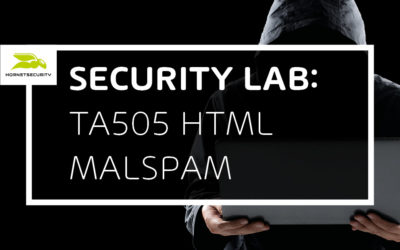IT Security Information
Get regular updates on current threats such as ransomware, phishing, CEO fraud and business email compromise.
Privacy Shield: The end of transatlantic data exchange?
+++ INFORMATION +++ Currently, it is recommended that affected data flows be identified and switched to alternatives that meet the required level of protection under GDPR. We would therefore like to assure you that Hornetsecurity's cloud email security services are...
Emotet is back
On 2020-07-17 the Hornetsecurity Security Lab detected the return of Emotet malspam. The reemerging Emotet malspam was already blocked by existing detection rules. The current Emotet malspam wave again uses malicious macro documents spread either via attachments or via malicious download links. As usual, the VBA macros in the document download the Emotet loader that the Hornetsecurity Security Lab has previously analyzed.
Firefox Send sends Ursnif malware
On 2020-07-07 Mozilla temporarily disabled their Firefox Send service due to abuse by malware. Hornetsecurity’s Security Lab explains how malware was abusing the Firefox Send service. To this end, a malspam campaign distributing a variant of the Ursnif malware is analyzed. The campaign used the Firefox Send service to host its malicious downloader and send victims these malicious Firefox Send links. Such abuse prompted Mozilla to disabled the Firefox Send service, because the service is currently lacking a feature to report abuse. Meaning even if researchers found these malicious links they could not be reported to Mozilla for takedown. However, our analysis further reveals that malware already abuses other services, hence, disabling Firefox Send – even though it was the right decision – has no impact on malware campaigns.
Clop, Clop! It’s a TA505 HTML malspam analysis
In this article Hornetsecurity’s Security Lab outlines one of the current infection chains by the operators behind the Clop ransomware. The outlined infection chain starts from an email with a malicious HTML attachment. This attachment redirects the victim to an XLS document containing the Get2 loader. This loader then installs a remote access trojan (RAT) on the system, which is used to prepare the victims network for the deployment of the Clop ransomware. The goal of the attack is to encrypt as many systems in the victims organization as possible in order to extort the highest possible ransom. To this end, the attackers also threaten to publish stolen data if the ransom is not paid.
QakBot malspam leading to ProLock: Nothing personal just business
FBI and the German federal CERT [1][2] are warning of current QakBot malspam distributing ProLock ransomware.
QakBot is spread via email. In the outlined campaign an email with a link to a ZIP archive containing a VBScript is used to download the QakBot Loader onto victim computers. From there the ProLock ransomware can potentially be loaded by the QakBot operators. The ProLock ransomware uses RC6 to encrypt files on the victims computer. It spares the first 8 KiB of all files. It appends a .proLock extension to encrypted files and leaves a ransom note stating that it is “[n]othing personal just business” and instructions on how to pay the ransom. However, the ransomware also deletes specific files ending with .bac or .bak extensions, so victims that pay will still loose those files.
Avaddon: From seeking affiliates to in-the-wild in 2 days
On 2020-06-03 it was reported that a new ransomware calling itself Avaddon was seeking partners for their affiliate program, i.e., someone installing the ransomware on victim systems. Just two days later on 2020-06-05 malspam distributing the Avaddon ransomware has been observed…
A Journey Through the History of Cryptography – Part 3
Our journey through the history of cryptography is coming to an end, but we still have a few last stations ahead of us. First we dealt with symmetric encryption and the encryption methods of Data Encryption Standard (DES) and Advanced Encryption Standard (AES), and in the last blog we introduced asymmetric encryption. In our final piece of the Cryptography triology, we will dive deeper into asymmetric encryption. Attack techniques such as man-in-the-middle attacks and brute force attacks will be examined. Finally, we will present a wide view into the future – keyword: quantum cryptography…
Information Stealer Campaign Targeting German HR Contacts
Hornetsecurity’s Security Lab presents insights into a long running information stealer campaign targeting German HR contacts with fake CV files.









